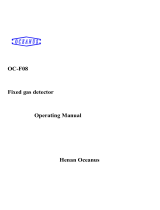
- 2 - GD-70D
<Contents>
Request for the Customers ..................................................................................... 1
1 Outline of the Product .................................................................................................... 4
1-1 Preface ............................................................................................................. 4
1-2 Product Purpose ............................................................................................... 4
1-3 Definition of DANGER, WARNING, CAUTION and NOTE .............................. 5
1-4 Method of confirmation for CE marking type .................................................... 5
2 Important Notices on Safety .......................................................................................... 6
2-1 Danger Statements ........................................................................................... 6
2-2 Warning Statements ......................................................................................... 6
2-3 Caution Statements .......................................................................................... 7
3 Product Components ..................................................................................................... 8
3-1 Main Unit and Standard Accessories................................................................ 8
3-2 Outline Drawing ................................................................................................ 9
3-3 Names and Functions for Each Part................................................................. 10
3-4 Operation Diagrams ......................................................................................... 14
4 Installation ...................................................................................................................... 16
4-1 Requirements ................................................................................................... 16
4-2 Precautions for Installation Sites ...................................................................... 16
4-3 Precautions for System Designing ................................................................... 18
4-4 Proper use of alarm contact ............................................................................. 19
4-5 Installing the Detector ....................................................................................... 20
4-6 Wiring the Detector ........................................................................................... 22
4-7 Making Tubing Connections ............................................................................. 34
4-8 Disposal ............................................................................................................ 35
5 Operation ....................................................................................................................... 36
5-1 Preparation for Start-up .................................................................................... 36
5-2 Starting Up the Detector ................................................................................... 36
5-3 Turning Off the Detector ................................................................................... 38
5-4 Basic Operation ................................................................................................ 38
5-5 Modes ............................................................................................................. 39
6 Detection Mode .............................................................................................................. 41
6-1 Gas Alarm Activation ........................................................................................ 41
6-2 Fault Alarm Activation ....................................................................................... 47
6-3 External Output Operation ................................................................................ 47
6-4 Other Functions ................................................................................................ 50
6-5 About LONWORKS (LN specification) ............................................................. 53
7 Alarm Test Mode ............................................................................................................ 57
7-1 Alarm Test Mode ............................................................................................... 57
8 User Mode ..................................................................................................................... 59
8-1 User Mode ........................................................................................................ 59
9 Maintenance Mode ........................................................................................................ 65
9-1 Environmental Setting 1 "2-9" ........................................................................... 70
9-2 Alarm Value Setting "2-9" - "SET 1" .................................................................. 71
9-3 Fault Alarm Test "2-9" - "SET 4" ....................................................................... 73
9-4 Environmental Setting 2 "2-10" ......................................................................... 74
9-5 Date/Time Setting "2-10" - "SET 1" .................................................................. 79
9-6 Energized/De-Energized Contact Setting "2-10" - "SET 6" .............................. 81
9-7 ETHERNET Setting "2-10" - "SET 18" ............................................................. 83
10 Maintenance .................................................................................................................. 86
10-1 Maintenance Intervals and Items ........................................................ 86
10-2 Calibration Overview ........................................................................... 86
10-3 Calibrating with the Target Gas ........................................................... 90
10-4 Calibrating with a Surrogate Gas (Sensors with Factors) ................... 93
10-5 Calibrating with a Gas Bag (Calibrating with HCl) ............................... 99
10-6 Calibrating with a Humidifier (MOS Sensors) ...................................... 103
10-7 Calibrating a Pyrolyzer Unit ................................................................. 107
10-8 Flow Rate Adjustments ........................................................................ 110
10-9 Replacing Parts ................................................................................... 112

























![Habor[2 Pack] Hygrometer Indoor Thermometer](http://vs1.manuzoid.com/store/data/000916902_2-3c87b04807d0857897e7e931f05d834f-160x210.png)